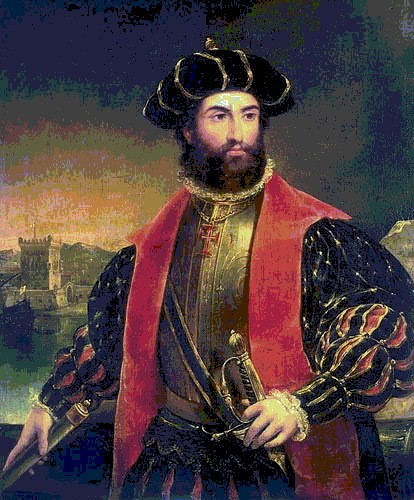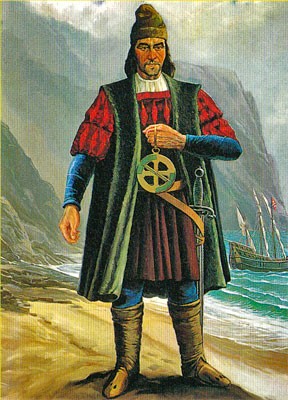PORTUGUESE MARINE TRAVELLING TO INDIA - PART II
![]()
(the begining of article: “Pedro Cabral and Portugal kingdom demonstrating hegemony in the Atlantic Ocean”)
The mission of Pedro Cabral was to break down resistance of inhabitants of India, to strengthen the influence of Portugal in those lands and to establish commercial relations. All these works had to be realized at peace. That’s why more than 1500 people had been drawn into the travel. More than 1000 of them were fighters.
The staff of Pedro Cabral’s expedition consisted of quite experienced and skilful seamen, which were participants of several previous travels. Boatswains were Bartolommeo Dias, who had discovered the south of Africa, Nicolau Coelho, who was participant of the first expedition travelled to India, and that expedition’s annalist Duarte Pacheco Pereira (1469-1533). There was special staff for establishment of commercial relations with India.
Staff participated in the expedition proves that the purpose of the expedition wasn’t to carry out exploration – it had political-diplomatic and commercial characteristics. Kinds of vessels (most of them were commercial), especially the vessel of commercial representation of the king are obvious proofs of it, those vessels had to establish commercial relations with India. Their leader Ayres Correia was personal representative of the king and he had to use all efforts and skills in order to establish permanent commercial representation of Portugal in India. Even corresponding city had been chosen for this purpose – Europeans had to found factory in that city and Ayres Correia had to work as the secretary of the factory.
Copper, velvet, woolen clothes and other goods had been shipped on warehouses of vessels. Food had been stocked for a year and a half. Pero Vaz de Caminha, Arabian translator Al Masud (Monsaidi), who worked within the staff of Vasco da Gama, expedition’s doctor, scientist, bachelor Juanish, eight Franciscan abbots working under the leadership of Enrique de Coimbra (he would work as a vicar in Calicut) and other religious employers had been attached to the secretary of the king in order to establish relations with Indian provinces in Calicut.
The expedition left the port of Lisbon on March 9, 1500. What was the task of the expedition, in general? Cabral had to maintain safety of vessels of Vasco da Gama, which had to travel to India and return to Portugal with valuable goods.
According to the plan, Pedro Cabral had to sail along the western coast of Africa 100 north latitude then he had to continue his travel towards the south-west in the open ocean.
This strange navigation course was chosen in order to maintain safety of the expedition, to save time and not to meet with unpleasant movements existing on coasts of the gulf of Guinea.


Vasco da Gama (1460-1524) Pero Vaz de Caminha (1450-1500)
Portuguese saw Brazilian coast on April 22, 1500 – on the holiday of Passover and so Brazil was discovered officially. But this discovery went down in history as an “accidental discovery”. It’s interesting that, Christopher Columbus also had mixed up that territory and Asia when he discovered the fourth continent in 1492.
May discoveries of world importance be accidental? After long researches, I came to the conclusion that expeditions having special missions meet with accidents during discoveries. Special tasks are given to leaders of expeditions before the travel and their real missions are kept secret.
Pero Vaz de Caminha noted in his letter addressed to the king Manuel I: “When we were at 660-670 liq away from San Nicolas Island of Green Cape Islands on April 21, we met with signs showing that coast isn’t far from us as sargass, sedum and birds and saw land on April 22. Some participants of the expedition went ashore and met indigenous population. They were black and quite naked. They had bows and arrows…” According to the information given by Caminha, any serious conflict didn’t occur between them and indigenous population. Nevertheless armed conflict occurred when Vicente Pinson and Diego Lepe went ashore in Brazil. But Pedro Cabral’s expedition didn’t meet with such difficulty. According to received information, indigenous population helped Portuguese to cut trees. Flora and fauna of that land amazed everybody.
After 9 days – on May 1 – Friday Pedro Cabral decided to put wooden cross with slogan and emblem of the king of Portugal on lands he had “discovered”. Even abbot Enrique de Coimbra blessed everybody at the religious ceremony held with the participation of indigenous population.
On the same day Pedro Cabral sent Gaspar de Lemos to Lisbon with his vessel in order to inform the king about lands he had “discovered”. He noted that, “discovered” territory would be called True Cross Island (Vera Cruz). According to historical sources, that news didn’t surprise Manuel I, though that “island” could be a stopping-place on the western way towards India. After some time, the king changed name of that territory, called it “Santa Cruz” (Holy Cross) and informed other monarchs of Europe about this fact.
Unlike expeditions of Pinson and Lepe, Cabral left some of his employees ashore. According to his order, two sea boys, who had been exiled and lived as deserters, were left ashore for ever.
The expedition left Brazilian coasts with 11 vessels on May 2, 1500 and according to the initial plan, went to the South of Africa and lost four vessels when passed the Cape of Good Hope. Unfortunately, Bartolommeo Dias, who had discovered the Cape of Good Hope in 1487, also was among dead travelers and his brother Diego Dias was lost along Mozambique coasts. Lost Diego Dias discovered the largest island of Africa – Madagascar and later returned back safe and sound.
 Bartolommeo Dias (1450-1500)
Bartolommeo Dias (1450-1500)Large land area discovered by Pedro Cabral in the western coast of the Atlantic Ocean wasn’t casual discovery, it was the greatest lie told by the Portugal Kingdom in XV century. It was impossible to lose way in the ocean, to sail thousands of kilometers blindfold with the expedition’s marine, its staff, experienced navigators and captains. As all islands located in the Atlantic Ocean were unknown for inhabitants of the Old World, Cabral could discover the nearest unknown islands. Besides it, it must be noted that, Bartolommeo Dias, Nicolau Coelho and other professional seamen were among members of the expedition. I want also note that, the route for travelling from Lisbon to India was chosen by Bartolommeo Dias and Vasco da Gama. Vasco da Gama also used that route when he travelled to India 3 years before this event – in 1497. According to the instruction, Cabral had to pass unpleasant currents and to sail to the Indian Ocean without approaching the Cape of Storms located in the south of Africa.
Best regards, the member of Azerbaijan Geographic Society,
President grant holder on literature, laureate of the “Golden pen” award,
writer/ investigator Ramiz Daniz

16962